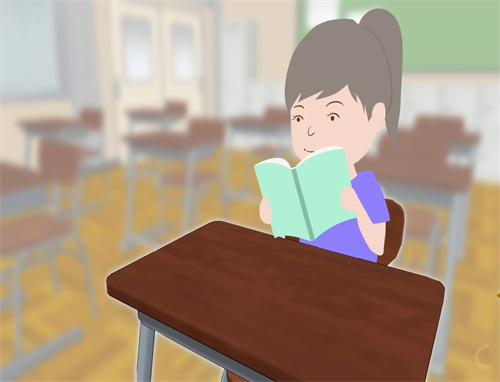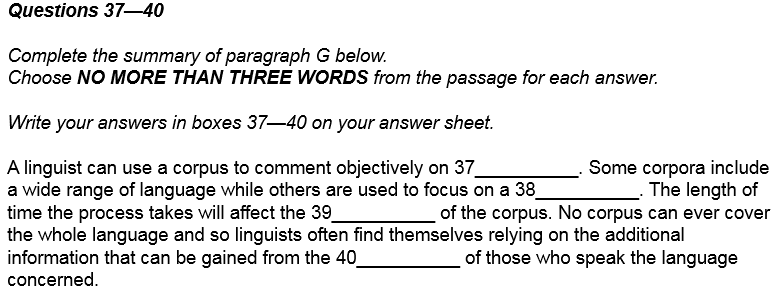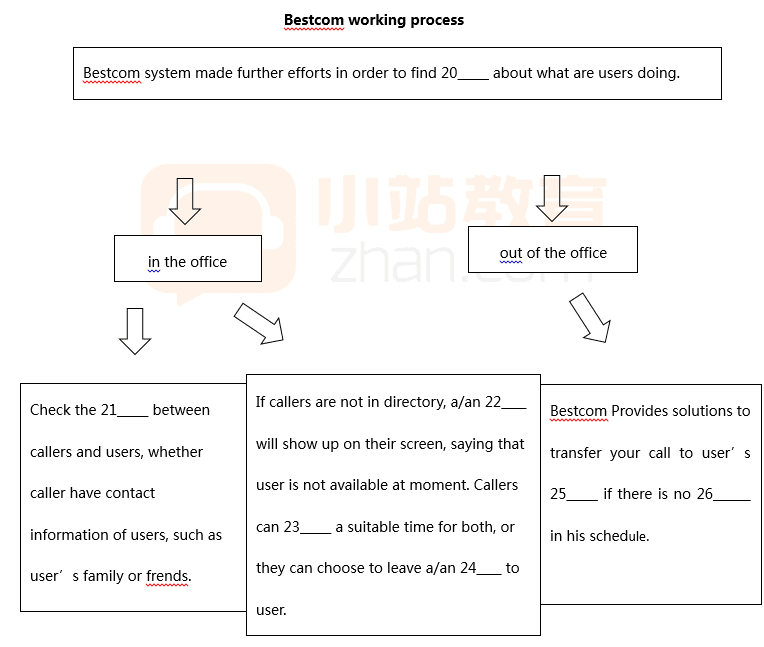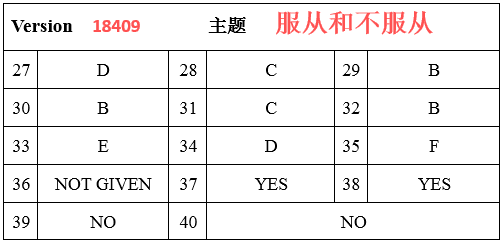一起来研究下阅读题型吧,知己知彼,百战不殆,今天小编给大家带来了雅思阅读14类题型解题技巧--Sentence completion(完成句子),希望能够帮助到大家,下面小编就和大家分享,来欣赏一下吧。
雅思阅读14类题型解题技巧--Sentence completion(完成句子)
Sentence completion(完成句子)
1. 题型要求
每个题目都是一个陈述句,但留有一个或两个空格,要求根据原文填空。目前考试中,绝大部分都是一个空格,而且在句子的结尾。
例如:The international community has begun to demand——
绝大部分的题目要求中有字数限制,一般有如下几种表达方式:(1) NO MORE THAN TWO/THREE/FOUR WORDS (不超过2/3/4个字);(2)ONE OR TWO WORDS (一个或两个字);(3)USE A MAXIMUM OF TWO WORDS(最多两个字)。有字数限制的,一定要严格按照要求去做,必须满足要求。
少部分的题目要求中没有字数限制,这时,请注意,答案字数也不会很长,一般不会超过四个字。
考试中,A类一般是每次必考,考一组,共三题左右。G类一般是两次考一次,考一组,共三题左右。
2. 解题步骤
(1) 找出题目中的关键词,最好先定位到原文中的一个段落。
将题目中的关键词与原文各段落的小标题或每段话的第一句相对照。有些题目能先定位到原文中的一个段落,这必将大大加快解题速度,并提高准确率。但也并非每个题目都能先定位到原文中的一个段落的。
(2) 从头到尾快速阅读该段落,根据题目中的其它关键词确定正确答案。
确定一个段落后,答案在该段落中的具体位置是未知的。所以,需要从头到尾仔细阅读该段落,找出题目中的关键词的对应词。仔细阅读对应词所在句子,确定正确答案。
(3) 要注意顺序性,即题目的顺序和原文的顺序基本一致。
NOTICE
1. 所填答案必须符合语法。同样有语法要求的题型是摘要填空(SUMMARY),而短问答则不太要求语法。
2. 绝大部分的答案来自原文原词。大部分的答案来自原文原词,而且是原文中连续的几个词。
3. 答案字数不会很长。
绝大部分的题目要求中有字数限制,这时必须满足要求。即使题目要求中没有字数限制,答案字数也不会很长,一般不会超过四个字。如果发现找到的答案字数很多,应首先怀疑自己找错答案的位置。
原文:In addition to basic residence fees, most universities make minor additional charges for items such as registration fees,damage deposits,and power charges.
题目:As well as the basic college residence fees, additional charges and usually made, but are describes as......
有的同学可能会答registration fees, damage deposits,and power charges.因为字数太多,所以应首先怀疑是错误的。正确答案应为Minor。即附加费用被描述为是少量的、微不足道的。
4. 答案绝大部分是名词短语。所填答案绝大部分是名词短语,对应原文相应句子的宾语。也有少数题目的答案是形容词短语或副词短语。
5. 要特别注意顺序性。
由于这种题型定位比较难,所以要特别注意顺序性的运用。一道题若找了很长时间、很多段落也没有找到答案,可能是因为题目中的关键词和原文中的相应词对应不明显,答案位置已经过去。可以先做下一道题。
这种题型比较难,所以通常出现为一篇文章的第二种或第三种题型。它与前面的题型也构成顺序性,即这种题型第一题的答案位置绝大部分应在前一种题型的最后一题的答案位置之后。
雅思阅读机经真题解析-儿童数学教育
A
It has been pointed out that learning mathematics and science is not so much learning facts as learning ways of thinking. It has also been emphasized that in order to learn science, people often have to change the way they think in ordinary situations. For example, in order to understand even simple concepts such as heat and temperature, ways of thinking of temperature as a measure of heat must be abandoned and a distinction between 'temperature' and 'heat' must be learned. These changes in ways of thinking are often referred to as conceptual changes. But how do conceptual changes happen? How do young people change their ways of thinking as they develop and as they learn in school?
B
Traditional instruction based on telling students how modem scientists think does not seem to be very successful. Students may learn the definitions, the formulae, the terminology, and yet still maintain their previous conceptions. This difficulty has been illustrated many times, for example, when instructed students are interviewed about heat and temperature. It is often identified by teachers as a difficulty in applying the concepts learned in the classroom; students may be able to repeat a formula but fail to use the concept represented by the formula when they explain observed events.
C
The psychologist Piaget suggested an interesting hypothesis relating to the process of cognitive change in children. Cognitive change was expected to result from the pupils' own intellectual activity. When confronted with a result that challenges their thinking—that is, when faced with conflict—pupils realize that they need to think again about their own ways of solving problems, regardless of whether the problem is one in mathematics or in science. He hypothesized that conflict brings about disequilibrium, and then triggers equilibration processes that ultimately produce cognitive change. For this reason, according to Piaget and his colleagues, in order for pupils to progress in their thinking they need to be actively engaged in solving problems that will challenge their current mode of reasoning. However, Piaget also pointed out that young children do not always discard their ideas in the face of contradictory evidence. They may actually discard the evidence and keep their theory.
D
Piaget's hypothesis about how cognitive change occurs was later translated into an educational approach which is now termed 'discovery learning'. Discovery learning initially took what is now considered the: 'lone learner' route. The role of the teacher was to select situations that challenged the pupils' reasoning; and the pupils' peers had no real role in this process. However, it was subsequently proposed that interpersonal conflict, especially with peers, might play an important role in promoting cognitive change. This hypothesis, originally advanced by Perret-Clermont and Doise and Mugny, has been investigated in many recent studies of science teaching and learning.
E
Christine Howe and her colleagues, for example, have compared children's progress in understanding several types of science concepts when they are given the opportunity to observe relevant events. In one study, Howe compared the progress of 8 to 12-year-old children in understanding what influences motion down a slope. In order to ascertain the role of conflict in group work, they created two kinds of groups according to a pre-test: one in which the children had dissimilar views, and a second in which the children had similar views. They found support for the idea that children in the groups with dissimilar views progressed more after their training sessions than those who had been placed in groups with similar views. However, they found no evidence to support the idea that the children worked out their new conceptions during their group discussions, because progress was not actually observed in a post-test immediately after the sessions of group work, but rather in a second test given around four weeks after the group work.
F
In another study, Howe set out to investigate whether the progress obtained through pair work could be a function of the exchange of ideas. They investigated the progress made by 12-15-year-old pupils in understanding the path of falling objects, a topic that usually involves conceptual difficulties. In order to create pairs of pupils with varying levels of dissimilarity in their initial conceptions, the pupils' predictions and explanations of the path of falling objects were assessed before they were engaged in pair work. The work sessions involved solving computer-presented problems, again about predicting and explaining the paths of falling objects. A post-test, given to individuals, assessed the progress made by pupils in their conceptions of what influenced the path of falling objects.
Questions 28-30
Choose THREE letters, A-F.
The list below contains some possible statements about learning
Which THREE of these statements are attributed to Piaget by the writer of the passage?
A Teachers play a big role in learning by explaining difficult concepts.
B Mental challenge is a stimulus to learning.
C Teaching should be consistent in order to easily acquire knowledge.
D Children sometimes ignore evidence that conflicts with their original believes.
E Children can help each other make cognitive progress.
F Cognitive progress is mainly relied on children's own intellectual activity.
Questions 31-33
Choose THREE letters, A-F.
Which THREE of these statements describe Howe's experiment with 8-12-year-olds children?
A The difference of learning progress between groups was obvious.
B The most active children made the least progress.
C The children were evaluated on their abilities to understand a physics phenomenon.
D The teacher aided the children to understand a scientific problem.
E A total of three tests were given to the children.
F All the children were working in mixed-ability groups.
Questions 34-37
Do the following statements agree with the hypothesis of the psychologist Piaget?
In boxes 34-37 on your answer sheet, write
TRUE if the statement is true
FALSE if the statement is false
NOT GIVEN if the information is not given in the passage
34 facing incompatible problems in different disciplines, students may be required to rethink their approach to solve the problem
35 Pupils learn new solutions by keep questioning their original ways of thinking.
36 With clear instructions, students could acquire new concepts with few problems.
37 Young children are less likely to change their concepts in problems of science than in mathematics.
Questions 38-40
Choose the correct letter. A, B, C or D.
Write the correct letter in boxes 38-40 on your answer sheet.
38 The Tone learner' route is an educational approach which
A is the main approach for discovery learning in many teaching now
B requires help from the pupils' peers.
C relies on how the teacher guides the students heavily.
D missed an important part for discovery learning.
39 it can be inferred from the passage as experiment in paragraph E
A that children acquire more when learning in groups.
B That children opposing each other would learn slower.
C Researches should check feedback right after the first test.
D There can be a satisfying result thanks to the duration of it.
40 Howe set out the pair work experiment in order to
A study how 12-15-years old pupils learn scientific concepts.
B assess whether teammates would have the features of exchange ideas.
C investigate pupils the ability of solving physics problems.
D predict and explain the path of falling objects.
文章题目:
Children’s acquiring the principles of mathematics and science
篇章结构
体裁
议论文
题目
儿童对于数学与科学原则的习得
结构
(一句话概括每段大意)
A段:儿童思维方式(认知)转变
B段:传统教学难以促进儿童的转变
C段:皮亚杰认为智力活动会导致认知改变
D段:皮亚杰的理论发展成“发现式学习”
E段:实验表明不同意见组比相同意见组进步多
F段:实验两人合作交换意见是否有助于取得进步
试题分析:
题目类型:
题号
定位词
文中对应点
题目解析
28-30
Piaget
段落C
A选项:教师通过解释难的概念在学习中扮演重要角色。原文没提到。
B选项:智力挑战促进学习。段落C倒数第三句。
C选项:为了容易获得知识,教学必须一致。原文没提到。
D选项:儿童有时会忽略与其原始理念违背的证据。段落C倒数两句。
E选项:儿童可以相互帮助达成认知进步。原文没提到
F选项:认知进步主要依赖于儿童自我的智力活动。段落C第二句。
31-33
Howe 8-12
段落E
A选项:两组学习进步的差别很明显。E段落倒数第二句。
B选项:最积极的学生进步最少。原文没提到
C选项:儿童被评估理解物理现象的能力。E段第二句理解斜坡上的移动。
D选项:教师辅助学生理解科学问题。有问题,原文没提到。
E选项:总共三个测试给到学生。原文没提到
F选项:所有的儿童在有各种能力层次的组中学习。原文没提到
34
Facing problem
段落C第三句
面对不同原则下的不同问题,学生可能要重新考虑解决问题的方法。对应段落C第三句,当面临挑战他们想法的结果,即面对冲突时,学生必须意识到他们需要重新思考解决问题的方法。因此答案为true.
35
Questioning original way
段落C第三句
学生通过质疑原始的思维方式习得新的解决方案。同上。因此答案为true.
36
Clear instruction
有着清晰的指导,学生在习得新概念时问题更少。有问题,原文没提到,答案应该是not given.
37
Challenge concepts
段落C第三句
相比数学,学生在面对科学问题的时候更不可能改变其观念。regardless of whether…science,不管是数学还是科学,所以比较错误。答案应该是false.
38
Lone learner
段落D第二句
第二句开始介绍lone learner.讲到发现式学习最初采用现在被认为是“单独学习者”的方法。在这种情况下,老师在没有学生同伴时,挑战学生的理解。
A选项:是现在许多发现式教学的主要方法。没有大的问题,故比较下来选A。
B选项:需要来自于同伴的帮助。矛盾,故不选。
C选项:十分依赖于老师指导学生的程度。没提到,故不选。
D选项:遗漏了发现式学习很重要的一步。矛盾,故不选。
39
段落E中实验
段落E
段落E讲了比较两组学生的进步情况,一组为争议大,一组为无争议,得出争议大的组进步大这一结论。但是因为并没有在实验后马上检验,没有证据支持。
A选项:组团学习的儿童获得更多知识。两组都有组团,故不选。
B选项:相互反对的儿童学得更慢。矛盾,故不选。
C选项:研究者应该在第一次实验结束后马上检测反馈。对
D选项:由于实验的持续性,应该有一个满意的结果产生。没提到,故不选。
40
Pair work experiment
段落F第一句
通过研究12-15岁学生理解物体降落的进步,调查通过通过交换意见是否有助于取得进步。实验前,先做了评估,再去检测进步。
A选项:研究12-15岁学生学习科学概念。研究内容而不是目的,故不选。
B选项:研究队员是否有交换想法的特点。
C选项:研究学生解决物理问题的能力。研究内容而不是目的,故不选。
D选项:预测和解释下降物体的途径。研究内容而不是目的,故不选。
参考译文:
(儿童)数学与科学的学习原理
A
已经有研究指出,学习数学和科学不像学习思考一样那么直观:也有人强调,学习科学知识的时候,人们往往不得不改变他们在普通的情况下的思维方式。(1题)例如,为了理解如热量和温度这样简单的科学概念,温度作为热量的衡量单位的思維方式必须被抛弃,‘温度’和‘热’之间的区别也必须学习。这些思维方式的变化通常被称为概念上的变化。但概念上的变化是怎么发生的呢?在青年人发展脑部和在校学习的时候,他们是如何改变思考方式的呢?
B
以传统的教学方法告诉学生现代科学家的思考方式似乎并不很成功。(2题)学生可以学习定义、公式和术语,但仍然维持其先前的概念。这个困境已经被说明很多次。例如,当被告知关于热能和温度后的学生受访时,教师往往发现同学在课堂上应用科学概念是会出现困难的。(10题)学生可以重复使用公式,但他们在使用公式背后的概念来解释观察到的现象时就不是很成功。
C
心理学家Piaget提出了一个在儿童认知转变的过程中的有趣的假设。认知转变被认为是自身智力行为的结果。当学生面临着一个挑战自己的想法的结果时,也就是说发生思想冲突的时候。不论这个是数学还是科学上的问题,学生就会发现他们需要重新思考他们解决问题的方法。(35题)他假设,冲突带来了不平衡,并触发了一个平衡过程,这也最终产生了认知转变。(3题)出于这个原因,Piaget和他的同事们认为学生为了让他们的思想进步,他们需要积极参与解决问题,挑战他们目前的推理模式。(9题)然而,Piaget还指出,在面对矛盾的证据时,年轻的孩子并不容易放弃自己的想法。实际上,他们还可能会放弃证据,并保持他们本来的理论。
D
Piaget的对于认知转变的假说后来被转化成现在被称为“发现学习”的教育方法。最初“发现学习”走了一条现在被称为“孤独学习”的道路。(4题)教师负责设定情况以挑战学生的推理能力,而其他同学是没有任何实质的角色的。然而,很多人随后提出人与人之间的冲击,尤其是同龄的人,可以对认知转变发挥到重要的作用。(39题)这一假说由Perret-Clermont(1980)和Doise与Mugny(1984)作了进一步研究,而这假说也被很多目前的科学教育所采用。
E
Christine Howe 和她的同事给予了小孩观察一些关于几个科学概念的事件时,对比了小孩们的认知进度。其中一个研究中,Howe在一群8到12岁的儿童理解什么因素影响山坡运动的进度时进行了对比。(5题)为了确定小组内会存在冲击,他们根据预测把小孩分成了两组:其中一组的孩子有不同的意见,另一组则抱有差不多的观点。Howe发现了支持他们观点的证据。(6题)组中儿童的不同看法使他们的培训课程比那个看法相似的组别更有效果。然而,Howe未能发现任何证据来支持孩子们是在课堂辩论中学到新的概念,这是因为后来的测试未有在第一时间进行,而是在小组讨论后的四个星期。(40题)
F
在另一项研究中,Howe着手调查两个人一起学习是否能够借交换意见来推进学习进度。(7题)他们调查了 12-15岁的学生在理解物体坠落的路径的过程。这个主题在概念上很容易出现认知困难,为了把学生分成一对一对在概念的程度上相异,Howe在学生分组前为学生的预测和解释物体坠落的路径进行了评估。学生的学习课程中需要解答在电脑上展示的难题,这也一样需要预测和解释物体坠落的路径。最后,学生会单独进行一个课后测试,评估他们对于什么影响到物体坠落的路径的概念上的进展。
参考答案:
Version 17104主题儿童数学教育
28
B
29
D
30
F
31
A
32
C
33
D
34
True
35
True
36
False
37
Not Given
38
D
39
C
40
B
雅思阅读14类题型解题技巧之完成句子相关文章:
★ 雅思阅读如何在1个月内有效提高
★ 雅思阅读高分技巧分享
★ 雅思阅读题型解题小技巧
★ 雅思阅读考试技巧
★ 3点思路和10个必知助你提升雅思阅读正确率
★ 雅思阅读新变化大盘点
★ 雅思阅读简答题解题技巧
★ 雅思阅读如何进行时间分配
★ 如何提升雅思阅读整体做题速度






